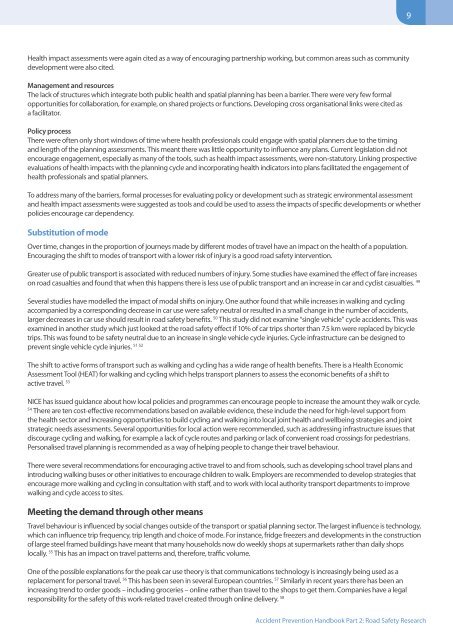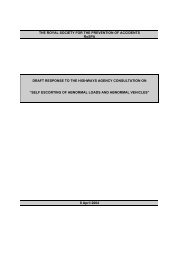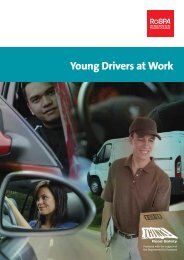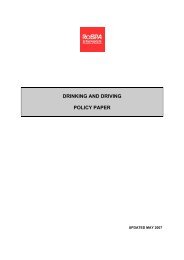Road safety policy and links to wider objectives - RoSPA
Road safety policy and links to wider objectives - RoSPA
Road safety policy and links to wider objectives - RoSPA
Create successful ePaper yourself
Turn your PDF publications into a flip-book with our unique Google optimized e-Paper software.
99<br />
Health impact assessments were again cited as a way of encouraging partnership working, but common areas such as community<br />
development were also cited.<br />
Management <strong>and</strong> resources<br />
The lack of structures which integrate both public health <strong>and</strong> spatial planning has been a barrier. There were very few formal<br />
opportunities for collaboration, for example, on shared projects or functions. Developing cross organisational <strong>links</strong> were cited as<br />
a facilita<strong>to</strong>r.<br />
Policy process<br />
There were often only short windows of time where health professionals could engage with spatial planners due <strong>to</strong> the timing<br />
<strong>and</strong> length of the planning assessments. This meant there was little opportunity <strong>to</strong> influence any plans. Current legislation did not<br />
encourage engagement, especially as many of the <strong>to</strong>ols, such as health impact assessments, were non-statu<strong>to</strong>ry. Linking prospective<br />
evaluations of health impacts with the planning cycle <strong>and</strong> incorporating health indica<strong>to</strong>rs in<strong>to</strong> plans facilitated the engagement of<br />
health professionals <strong>and</strong> spatial planners.<br />
To address many of the barriers, formal processes for evaluating <strong>policy</strong> or development such as strategic environmental assessment<br />
<strong>and</strong> health impact assessments were suggested as <strong>to</strong>ols <strong>and</strong> could be used <strong>to</strong> assess the impacts of specific developments or whether<br />
policies encourage car dependency.<br />
Substitution of mode<br />
Over time, changes in the proportion of journeys made by different modes of travel have an impact on the health of a population.<br />
Encouraging the shift <strong>to</strong> modes of transport with a lower risk of injury is a good road <strong>safety</strong> intervention.<br />
Greater use of public transport is associated with reduced numbers of injury. Some studies have examined the effect of fare increases<br />
on road casualties <strong>and</strong> found that when this happens there is less use of public transport <strong>and</strong> an increase in car <strong>and</strong> cyclist casualties. 49<br />
Several studies have modelled the impact of modal shifts on injury. One author found that while increases in walking <strong>and</strong> cycling<br />
accompanied by a corresponding decrease in car use were <strong>safety</strong> neutral or resulted in a small change in the number of accidents,<br />
larger decreases in car use should result in road <strong>safety</strong> benefits. 50 This study did not examine “single vehicle” cycle accidents. This was<br />
examined in another study which just looked at the road <strong>safety</strong> effect if 10% of car trips shorter than 7.5 km were replaced by bicycle<br />
trips. This was found <strong>to</strong> be <strong>safety</strong> neutral due <strong>to</strong> an increase in single vehicle cycle injuries. Cycle infrastructure can be designed <strong>to</strong><br />
51 52<br />
prevent single vehicle cycle injuries.<br />
The shift <strong>to</strong> active forms of transport such as walking <strong>and</strong> cycling has a wide range of health benefits. There is a Health Economic<br />
Assessment Tool (HEAT) for walking <strong>and</strong> cycling which helps transport planners <strong>to</strong> assess the economic benefits of a shift <strong>to</strong><br />
active travel. 53<br />
NICE has issued guidance about how local policies <strong>and</strong> programmes can encourage people <strong>to</strong> increase the amount they walk or cycle.<br />
54<br />
There are ten cost-effective recommendations based on available evidence, these include the need for high-level support from<br />
the health sec<strong>to</strong>r <strong>and</strong> increasing opportunities <strong>to</strong> build cycling <strong>and</strong> walking in<strong>to</strong> local joint health <strong>and</strong> wellbeing strategies <strong>and</strong> joint<br />
strategic needs assessments. Several opportunities for local action were recommended, such as addressing infrastructure issues that<br />
discourage cycling <strong>and</strong> walking, for example a lack of cycle routes <strong>and</strong> parking or lack of convenient road crossings for pedestrians.<br />
Personalised travel planning is recommended as a way of helping people <strong>to</strong> change their travel behaviour.<br />
There were several recommendations for encouraging active travel <strong>to</strong> <strong>and</strong> from schools, such as developing school travel plans <strong>and</strong><br />
introducing walking buses or other initiatives <strong>to</strong> encourage children <strong>to</strong> walk. Employers are recommended <strong>to</strong> develop strategies that<br />
encourage more walking <strong>and</strong> cycling in consultation with staff, <strong>and</strong> <strong>to</strong> work with local authority transport departments <strong>to</strong> improve<br />
walking <strong>and</strong> cycle access <strong>to</strong> sites.<br />
Meeting the dem<strong>and</strong> through other means<br />
Travel behaviour is influenced by social changes outside of the transport or spatial planning sec<strong>to</strong>r. The largest influence is technology,<br />
which can influence trip frequency, trip length <strong>and</strong> choice of mode. For instance, fridge freezers <strong>and</strong> developments in the construction<br />
of large steel framed buildings have meant that many households now do weekly shops at supermarkets rather than daily shops<br />
locally. 55 This has an impact on travel patterns <strong>and</strong>, therefore, traffic volume.<br />
One of the possible explanations for the peak car use theory is that communications technology is increasingly being used as a<br />
replacement for personal travel. 56 This has been seen in several European countries. 57 Similarly in recent years there has been an<br />
increasing trend <strong>to</strong> order goods – including groceries – online rather than travel <strong>to</strong> the shops <strong>to</strong> get them. Companies have a legal<br />
responsibility for the <strong>safety</strong> of this work-related travel created through online delivery. 58<br />
Accident Prevention H<strong>and</strong>book Part 2: <strong>Road</strong> Safety Research

















